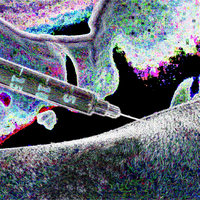| Genistein | |
|---|---|
| Esters [] | |
|---|---|
| Genistein acetate | |
| Molecular structure via molpic based on CDK |
| Physical properties [] | |
|---|---|
| Molecular mass | 270.24 g/mol [1] |
| Appearance | Rectangular or six-sided rods from 60% alcohol. Dendritic needles from ether [1] |
| Melting point | 297-298 °C (slight decomposition) [1] |
| Solubility | Soluble in the usual organic solvents; soluble in dilute alkalies with yellow color. Practically insoluble in water. [1] |
| Predicted LogP | 2.7 [1] |
| Structural Identifiers [] | |
|---|---|
| Molecular formula | C15H10O5 [1] |
| IUPAC name | 5,7-dihydroxy-3-(4-hydroxyphenyl)chromen-4-one [1] |
| SMILES | C1=CC(=CC=C1C2=COC3=CC(=CC(=C3C2=O)O)O)O [1] |
| InChI | InChI=1S/C15H10O5/c16-9-3-1-8(2-4-9)11-7-20-13-6-10(17)5-12(18)14(13)15(11)19/h1-7,16-18H [1] |
| InChIKey | TZBJGXHYKVUXJN-UHFFFAOYSA-N [1] |
Genistein
Genistein (also known as Prunetol, 4',5,7-Trihydroxyisoflavone, Genisterin, Genisteol, Sophoricol, 5,7-dihydroxy-3-(4-hydroxyphenyl)-4H-chromen-4-one, 5,7,4'-Trihydroxyisoflavone, Bonistein, Genestein or Differenol A)
Chemistry
Esters []
Genistein is typically found in the form of its acetate ester.
Stereochemistry []
Genistein is a achiral mixture
 Anodyne
Anodyne